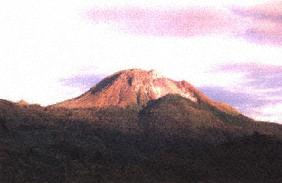|
Davao is the
home of the ethnic Bagobo, Mandaya, Manobo, Tiboli, Mansaka, and B'laan tribes. Tribal
settlements were mostly found along the banks of the mighty Davao River. The name Davao
was derived from the word Daba-daba which evoked images of fire-breathing mythical figures
and rituals of fire set before tribal wars. The other settlers along the banks of the
Davao River were tribes from the neighboring provinces of Kotabato, Zamboanga, and Jolo.
Earlier conquests by the Spaniards failed until the mid-19th century when they were able
to overrun the Moslem enclaves in Davao. Christian settlers arrived soon after the
conquest.
Today, Davao is also a multifaceted
tourist destination. People who come here for conventions can also enjoy other things like
nature, fresh fruits, the lovely flowers and various nature sports like rappelling which
you aptly demonstrated in the opening of the Mindanao Travelmart. Of course, other sports
being promoted are tubing and white water sports, mountain climbing, mountain biking and
scuba diving.
Metropolitan Davao, considered one
of the world's largest cities in terms of land area, covering 244,00 hectares of land
wherein about 70% of which is characterized by extensive mountain ranges with uneven
distribution of plateaus and lowlands. Vegetation covers in the city are grouped into four
types, namely, forest, grasslands, swamps and cultivated crops. Davao is approximately 7.8
times the size of Cebu and 3 times that of the entire Metro Manila. It is located on the
west central part of Southern Mindanao, in the southernmost portion of the island of
Mindanao. It is subdivided into 11 administrative districts, namely, Poblacion, Talomo,
Buhangin, Bunawan, Agdao, Paquibato, Toril, Tugbok, Calinan, Baguio and Marilog Districts.
Geographically, the city is located near the equator, approximately 6 degrees, 58 minutes,
North Latitude and 125 degrees, 14 minutes, East Longitude. Davao is approximately 946
aerial kilometers or 588 statute miles southeast of Manila and 241 statute miles to Cebu
City. Its strategic location in Asia makes it a transit point between Australia-Oceana and
the East Asia-Pacific regions.
Davao City is home to about 1.3
million people with an annual population growth rate of 3.22%. Its inhabitants are of
mixed ethnic origin representing people from all regions of the Philippines with major
traces of Malay, Chinese, Spanish and Arabic heritage. Cebuano is the dominant ethnic
dialect while Filipino constitutes one of the major spoken languages which include English
and Chinese. Davao is predominantly Roman Catholic. Other faiths practiced are
Protestantism and Islam.
Davao enjoys a mild pleasant
tropical climate with no pronounced dry or wet season, and is practically free from
typhoon, which is a boon to tourism and agriculture. Average temperature is from 20.8C to
32C and average rainfall is up to 2,000 mm yearly.
Agriculture, fishery and forestry
contribute 40% to the city's economic performance while 25% from industry and the 35% from
the service sector. Only 5% of the total land area of Davao is utilized for commercial,
industrial, institutional and residential purposes. Top exports include banana, crude and
refined coconut oil, activated carbon, copra, plywood and copper ore concentrates.
|
|



DAVAO CITY PHOTOS
|